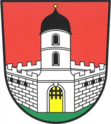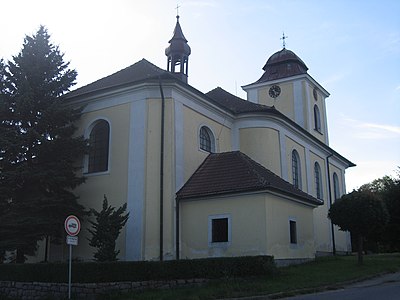Větrný Jeníkov
| Větrný Jeníkov | ||||
|---|---|---|---|---|
|
||||
| Basic data | ||||
| State : |
|
|||
| Region : | Kraj Vysočina | |||
| District : | Jihlava | |||
| Area : | 1222 ha | |||
| Geographic location : | 49 ° 29 ' N , 15 ° 29' E | |||
| Height: | 665 m nm | |||
| Residents : | 634 (Jan. 1, 2019) | |||
| Postal code : | 588 42 | |||
| License plate : | J | |||
| traffic | ||||
| Street: |
Štoky - Vyskytná Jihlava - Humpolec |
|||
| structure | ||||
| Status: | Městys | |||
| Districts: | 2 | |||
| administration | ||||
| Mayor : | Martina Lisová (as of 2018) | |||
| Address: | Větrný Jeníkov 5 588 42 Větrný Jeníkov |
|||
| Municipality number: | 588121 | |||
| Website : | mesta.obce.cz/vetrny-jenikov | |||
Větrný Jeníkov (German Windig Jenikau ) is a minority town in the Czech Republic . It is located twelve kilometers northwest of the city center of Jihlava halfway to Humpolec and belongs to the Okres Jihlava .
geography
Větrný Jeníkov is located in the basin of a left tributary of the Jiřínský potok in the Bohemian-Moravian Highlands . The place is on the European main watershed between the Elbe and Danube. The route of the D 1 motorway runs almost three kilometers to the north-east , where exit 104 Větrný Jeníkov is also located . To the north rises the Novota (689 m), in the northeast the Skalky (708 m), east the Venušín (678 m), southeast the Peklo (699 m), in the south the Trojan (569 m) and Holubovsko (675 m), southwest of the Strážník (713 m).
Neighboring towns are Zbinohy in the north, Na Skalce, Kosovy and Petrovice in the north-east, Smrčensko and Smrčná in the east, Vilémovské Chaloupky, Stará Huť and Bílý Kámen in the south-east, Struhovec, U Trojanů, Hlávkov and Jiřín in the south, and Šimanov in the south-west , Branišov, Ústí and Kalhov in the west and Velešov and Velešovský Dvůr in the northwest.
history
The first written mention of Jeníkov took place in 1226 together with other places in a certificate of ownership Honorius III. for the Seelau monastery . Its location on the Humpoletzer or Seelauer Steig, which led to the rich mountain town of Iglau , promoted the development of the place. In the 14th century Jenikau was raised to a town and received the right to use a coat of arms.
In 1436 , King Sigismund handed over the Seelau monastery property, orphaned during the Hussite Wars , to the protection and administration of Nikolaus Trčka von Lípas with the consent of the abbot who had fled to Iglau . After Georg von Podiebrad had assigned the monastery property to the Trčka von Lípa in 1458 in the land tablet, Burian Trčka von Lípa established the Jenikau dominion. Since 1572 the town has been called Větrný Jeníkov / Windig Jenikau. 1601 Trčka sold selected from the parties and the town Windig Jenikau with brewery and Vorwerkshof and 22 villages, including Buková, Chyška , Dudin , Scheibel village , Mysletín , Winau , Opatau , Keller village , Vorlovy, Polánky, Neustift , Prusdorf and bollard churches existing rule Jenikau to Matthias Stubegg Knight of Königstein ( Matyáš Štubík z Königštejna ) , who came from an ennobled Iglauer patrician family . His sons shared the property in 1606 and Samuel Stubegg received the Jenikau share with the town of Windig Jenikau and the villages of Winau, Opatau, Dudin, Maršov, Duschau , Jankau , Kalhau , Prusdorf and Chyška. After his death, Magdalena Trčka von Lobkowicz acquired the rule in 1619.
During the Thirty Years' War, the area became impoverished and subsequently foreign Catholic nobles quickly took turns as owners and pushed through the re-Catholicization of the population. Under Johann Baptist Ritter von Minetti, who bought the property in 1719, building activity began. Minetti had a new church and school built and the fortress transformed into a baroque palace. The craft flourished and in 1721 guilds were formed in Windig Jenikau. Part of his inheritance flowed into a public foundation of a Prague hospital, which subsequently leased the estate to various owners. Mainly it belonged to the Barons von Dyhrn , the Saxon relatives of the Minettis. General Georg Karl von Dyhern, who died in the Battle of Bergen in 1759 , also lived here . This family ruled Windig Jenikau for half a century. In 1838 the Counts of Rummerskirch bought the rule from the previous owner.
After the abolition of patrimonial Větrný Jeníkov / Windig Jenikau formed a market town in the district of Deutschbrod with the district Velšov from 1850 and had the right to hold six annual fairs. At the beginning of the 20th century, Větrný Jeníkov was assigned to the Humpolec district. In 1904 Richard Fiedler bought the castle with the associated large estates. His widow Franziska sold the goods to Franz von Magnoni in 1909, who passed them on to Otto Mettal two years later .
In 1927 the Graf Straka Foundation acquired the goods, which had been reduced in size by the first land reform. In 1948 the goods were nationalized. Since 1961 Větrný Jeníkov belongs to Okres Jihlava .
On March 20, 2008, a mass accident occurred on the nearby D1 motorway at kilometer 100 shortly before the Větrný Jeníkov exit with damage of 27,863,000 crowns , in which 131 cars, 98 trucks and two buses were involved, and three were serious - and there were 27 slightly injured people.
On January 23, 2009 the place got the status of a Městys back.
Local division
The Městys Větrný Jeníkov consists of the districts Velešov ( Welschau ) and Větrný Jeníkov ( Windig Jenikau ).
Attractions
- Větrný Jeníkov Castle, the baroque building was built in 1729 for Johann von Minetti from an old fortress
- Church of Mariä Wiegenfest, built 1720–1735 in place of a previous building
- Statue of St. John of Nepomuk in front of the church, on the base of the work of art created in 1721 is the coat of arms of the Knights of Minetti
- Chapel in Velešov
- Watermill Dolní Mlýn ( Untermühle ) on Jiřínský creek south of the village
- Jewish cemetery , south of the Dolní Mlýn
- Černý rybník pond with a holiday complex, east of the village





